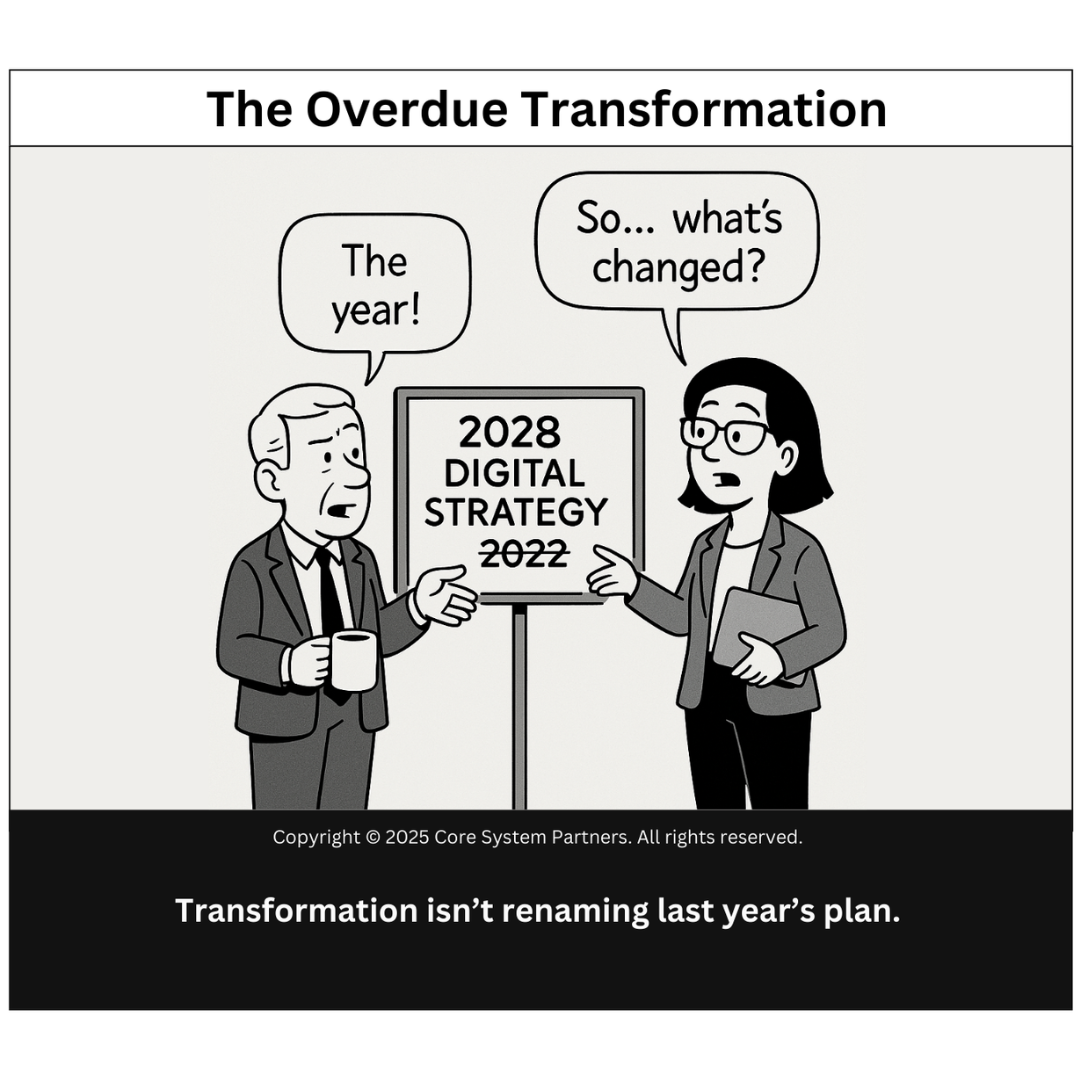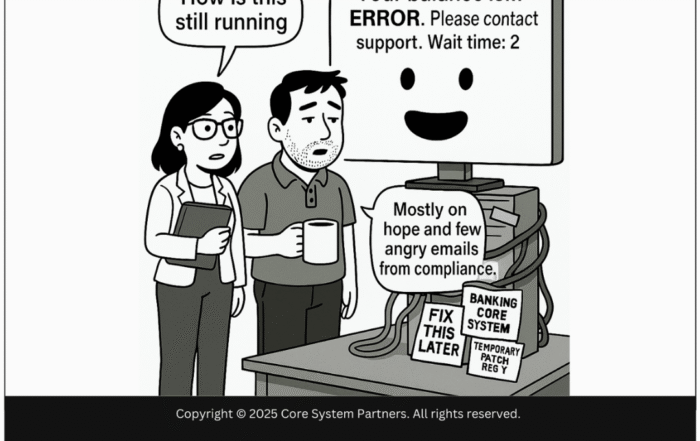
A satirical look at transformation roadmaps that don’t change—just the date on the cover.
“So… what’s changed?”
“The year!”
We’ve all sat in that meeting. A flashy new transformation roadmap is unveiled, but after a few minutes of polite head nods, someone asks the question everyone’s thinking: “Isn’t this just last year’s plan with a new cover slide?”
If that sounds familiar, you’re not alone. It’s a common symptom of strategic stagnation masked as progress. Updating the date on your digital strategy doesn’t make it forward-looking—it just buys time, and not in a good way.
Let’s talk about why this happens, why it’s risky, and what real transformation actually looks like.
The “Recycled Strategy” Trap
In banking (and let’s be honest, in most industries), it’s tempting to delay hard decisions and slap a fresh label on old thinking. There are plenty of reasons:
- Change fatigue
- Budget constraints
- Stakeholder indecision
- Fear of failure
But here’s the problem: transformation isn’t about looking busy—it’s about delivering better outcomes. And outdated plans wrapped in new timelines won’t get us there.
What’s Really at Stake
When banks rely on cosmetic updates instead of courageous strategy, the cost is more than just time. It’s:
- Eroded trust – Front-line teams recognize when the plan hasn’t changed. And they disengage.
- Lost momentum – Without visible progress, stakeholder buy-in fades fast.
- Strategic drift – The organization moves… but not necessarily in the right direction.
- Market irrelevance – Competitors with true transformation strategies begin to leapfrog your position.
“Transformation delayed is transformation denied. And in banking, delay is expensive.”
Is It a Plan or Just a Postpone?
Here’s a quick litmus test to check if your “new” strategy is actually new:
- Does it have updated assumptions based on today’s market?
- Are the priorities reshuffled to reflect what’s changed?
- Have you added—or removed—capabilities based on learnings?
- Did you involve a fresh set of voices in shaping it?
- Are there clear metrics that weren’t there last time?
If not, you might just be updating the title slide.
What Real Transformation Demands
True transformation requires more than updating a PDF. It demands rethinking how your bank operates, competes, and serves customers.
1. Clarity Over Cosmetics
Forget jargon-filled 50-slide decks. Start with clear answers to tough questions:
- What are we solving for?
- Who benefits—and how?
- What’s different from our current state?
2. Execution-Ready Roadmaps
A strategy that can’t be executed isn’t a strategy—it’s a wish. Focus on:
- Clear phases and owners
- Budget alignment
- Measurable milestones
- Risk mitigation plans
3. Feedback Loops That Matter
Plans should evolve as you learn—not annually, but continuously.
- Use retrospectives after major initiatives
- Monitor real-time data and course-correct early
- Give teams permission to say “this isn’t working”
4. Commitment, Not Compliance
Transformation can’t just be a mandate from the top. It has to be a movement across the org.
- Involve cross-functional teams early
- Recognize and celebrate early wins
- Communicate consistently and candidly
From Copy-Paste to Competitive Edge
We recently worked with a mid-sized bank whose “2025 strategy” had already been pushed out twice. When we got into the details, it was clear they were chasing the same initiatives with no meaningful progress—just new buzzwords.
Instead of pushing another date, they hit pause and did a readiness assessment. The results were sobering: tech stack misalignment, stakeholder fatigue, no clear metrics.
But that clarity led to action.
They re-sequenced their roadmap, scrapped initiatives that no longer served the business, and narrowed focus to three transformation priorities. They didn’t just rename the plan—they rebuilt it. And now? They’re making visible progress in months, not years.
Questions Worth Asking Right Now
If your team is heading into another strategy refresh, here are a few questions worth posing in the room:
- What’s different in the market since we last planned?
- What feedback have we gotten from customers or employees that should influence direction?
- Which initiatives are no longer serving us—and why haven’t we stopped them?
- What risks are we not talking about?
- How will we measure real progress?
Transformation Doesn’t Happen in Slides
It happens in systems. In people. In decisions made and habits changed.
So next time someone says, “We’ve updated the plan,” ask them how. Ask them what’s changed. Ask them what they’re doing differently starting tomorrow.
Because strategy isn’t about the year stamped on the cover. It’s about the courage to actually move forward.
Ready to Break the Loop?
If your organization is stuck in the strategy rinse-and-repeat cycle, our Optimize® Assessment can help.
It cuts through the noise and shows you where you’re truly prepared—and where you’re not.
Because transformation isn’t a label. It’s a leap. Let’s make it worth taking.
#CoreBankingTransformation #CoreBankingOptimization





